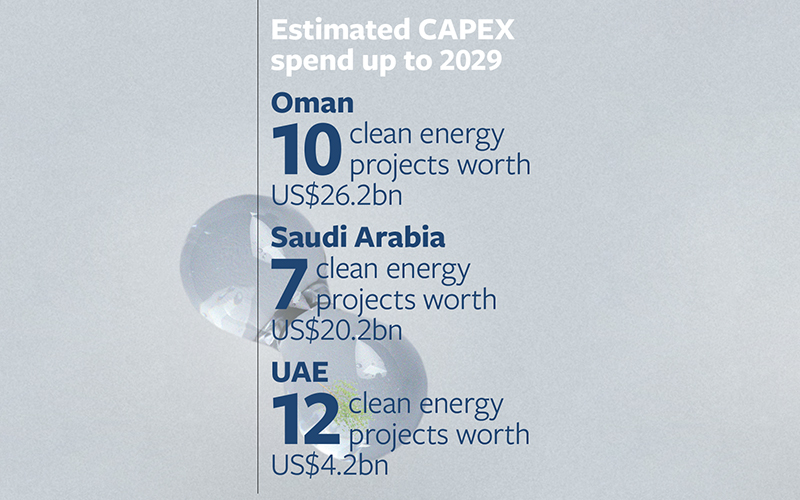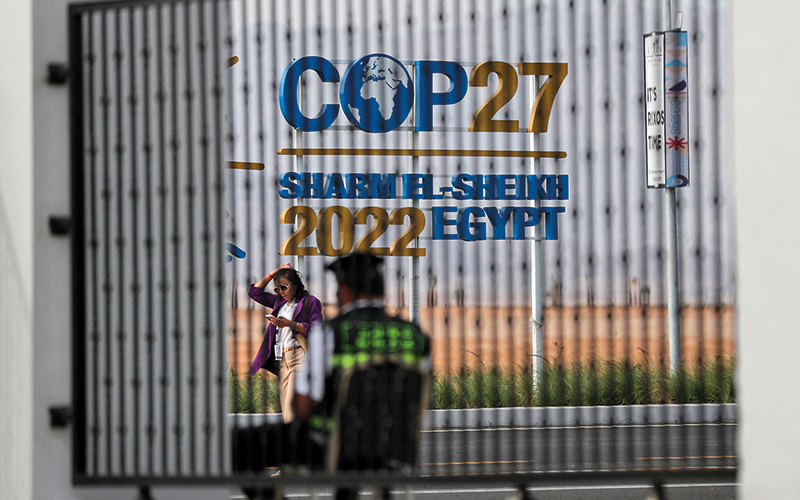Oman, Saudi Arabia and UAE lead GCC clean energy investments
The Gulf Cooperation Council (GCC) economies represent an enormous opportunity for EIC members. As the region pivots from fossil fuels, GCC states are well-positioned to lead the energy transition through clean hydrogen development and strong policy support.
Across the region, the political will to decarbonise at pace is lining up investors. And although ambitions vary among countries, as do market size and readiness, there is a prevailing sense of dynamism.
But which markets should you consider exporting to in 2023? Oman, Saudi Arabia and UAE, says Wan Afiq, Energy Analyst for Middle East and North Africa at EIC

In October 2022, Oman joined the UAE and Saudi Arabia in becoming the third GCC country to commit to achieving net-zero emissions by 2050, in alignment with the goals of the Paris Agreement.
Following the UAE and Saudi Arabia, which made their net-zero pledges in 2021, and according to EICDataStream, Oman now leads the way with its plans to capitalise on a range of clean energy investments throughout the country.
Oman
- 100% foreign ownership
- Low-cost loans
- No minimum capital requirement for business setup
- Significant tax incentives
- 100% customs duty exemption

In the GCC, Oman is racing ahead with clean energy investment and development. EICDataStream is tracking 10 active and planned projects worth more than US$26bn CAPEX. The country aims to be a leading green hydrogen hub, with over 99% of estimated CAPEX for energy transition projects in the hydrogen sector; the other 1% is invested in energy storage.
Who are the key players?
Major companies active in Oman’s energy transition sector include OQ (formerly known as Oman Oil Company), Intercontinental Energy, Marubeni Corporation and ACME. During the last 12 months, international contractors that have been successful in Oman in Oman include KBR, DNV GL and Worley.
Future opportunities worth US$140bn
Clean energy is one of the key sectors targeted by Oman Vision 2040 and the Sultanate’s national strategy for energy. Oman launched its Green Hydrogen Strategy in October 2022, setting a production target of 1–1.25mtpa by 2030. By 2040 it hopes to be producing up to 3.25–3.75mtpa, rising to 8.5mtpa by 2050. Oman estimates it will require investment of US$140bn by 2050 to reach the hydrogen production goal. It also set up a state-owned company, Hydrogen Oman, to oversee growth of a green hydrogen-based economy.
Why invest?
Oman has a vibrant economy and an open attitude toward foreign investment. The government is making the country more attractive to foreign investors by improving infrastructure and creating new laws that will simplify investment procedures, reduce bureaucratic hurdles and provide various tax exemptions and incentives.
The establishment of a US$5.2bn investment fund, called the Oman Future Fund, is set to be a catalyst for foreign direct investment and will be under the management of the Oman Investment Authority.
Saudi Arabia
- Competitive corporate tax rates
- Customs duties exemptions
- 100% foreign ownership
- Flexibility in employing foreign labour
- Low-cost loans
EICDataStream ranks Saudi Arabia second in the GCC in terms of CAPEX for ongoing and planned clean energy projects, with seven developments worth US$20.2bn currently being tracked. In October 2021, Saudi Arabia announced plans to become the largest producer of low-carbon hydrogen by targeting the production of around 4mtpa of hydrogen by 2030. It also aims to capture carbon of 44mtpa by 2035, to achieve net zero emissions by 2060.
Projects to note include the US$8.4bn NEOM green hydrogen plant, to be powered by 4GW of solar and wind energy, and expected to produce 600–650 tonnes of green hydrogen per day. The project secured a financial close with a value of US$8.4bn in May 2023. Also, the US$4.5bn Jubail industrial city carbon capture and storage hub, expected to come online by 2027 – the first phase of the hub will be able to store and utilise 9mtpa of CO2.
Saudi Arabia is keen to attract hydrogen and carbon capture projects
Who are the key players?
Saudi Arabia is keen to attract hydrogen and carbon capture projects and has partnered with international investors including ADNOC, Brooge Renewable Energy and Masdar. Contractors ThyssenKrupp, ACWA Power, Larsen & Toubro and Baker Hughes have all been successful in winning contracts during the last year.
Saudi Arabia’s competitive edge
A study conducted by the King Abdullah Petroleum Studies and Research Centre states that the price of green hydrogen in Saudi Arabia could be one of the lowest in the world. While the global hydrogen price range is US$2–7 per kg, according to the research, Saudi Arabia will be able to reach US$1 per kg in the long term due to the country’s low natural gas and renewable energy prices.
Why invest?
Saudi Arabia is developing policies and regulatory instruments to drive technologies in hydrogen development to commercial readiness. The list of incentives released to date covers a wide range of financial and non-financial incentives. These include, but are not limited to, tax incentives, government subsidies, relaxed Saudisation requirements and discounts on government fees. Funding initiatives include the Saudi Industrial Development Fund, the National Infrastructure Fund and the National Development Fund.
Saudi Arabia
Green Hydrogen Production Facility – NEOM and ACWA Power
- Value: US$8.4bn
- Start up: 2026
- Stage: Engineering, procurement and construction (EPC)
- Status: Contract awarded
- Operators: NEOM, ACWA Power, Air Products & Chemicals
Jubail Industrial City Carbon Capture & Storage Hub
- Value: US$4.5bn
- Start up: 2027
- Stage: Feasibility study
- Status: Memorandum of Understanding (MoU)
- Operators: Saudi Aramco, Linde, Schlumberger
Green Hydrogen – PIF, Samsung C&T & POSCO
- Value: US$6.5bn
- Startup: 2029
- Stage: Feasibility study
- Status: MoU
- Operators: Samsung C&T, Posco, Korean Southern Power, Korea Electric Power Corporation, Korea National Oil Corporation
Oman
Green Energy Oman
- Value: US$10bn
- Start up: 2028
- Stage: Feasibility study
- Status: Contract awarded
- Operators: Intercontinental Energy, OQ, EnerTech, Shell
Duqm Green Ammonia & Hydrogen Project – Acme
- Value: US$3.5bn
- Start up: 2025
- Stage: EPC
- Status: Contract awarded
- Operators: Tatweer Petroleum, ACME Solar
SalalaH2 Green Hydrogen & Ammonia Project
- Value: US$1bn
- Start up: 2028
- Stage: Feasibility study
- Status: Planning
- Operators: OQ, Marubeni Corporation, Linde Group, Dutco
Source of project information: EICDataStream
United Arab Emirates
- Up to 100% foreign ownership in free zones
- 100% foreign ownership across 13 sectors
- 100% profit repatriation
- No minimum capital requirement for business setup
- Competitive financing costs
With 12 active and planned clean energy projects representing a total potential investment value of US$4.2bn, the UAE ranks third in the GCC in terms of capital expenditure.
The country launched its Hydrogen Leadership Roadmap during COP26 in 2021, setting a target to capture a quarter of the world’s clean hydrogen market by 2030. To explore the opportunities of the hydrogen sector, the UAE has formed the Abu Dhabi Hydrogen Alliance, which consists of Mubadala Investment Company, ADQ, ADNOC and the Ministry of Energy and Infrastructure.
As well as actively pursuing clean energy strategic partnerships with countries including Brazil, the Netherlands, the UK and the US, the UAE has formed partnerships with countries such as Japan, India and Germany to export hydrogen. It also formed a partnership with South Korea for the ADNOC blue ammonia production, a facility joint research and a demonstration project located in Ruwais. To test its capabilities as a hydrogen exporter, the UAE sold four test cargoes of blue ammonia in 2021 to Itochu, Idemitsu and INPEX, all based in Japan.
The UAE is also the home of the Al Reyadah Carbon Capture, Utilisation and Storage (CCUS) Plant, the Middle East’s first commercial-scale CCUS plant, which currently captures 0.8mtpa of CO2. As part of its US$15bn to advance an array of projects across its diversified value chain by 2030, ADNOC plans to expand the plant’s capacity by over 500%, reaching 5mtpa of CO2 by 2030.

All eyes are on the UAE this year as it prepares to host COP28 in November
Who are the key players?
Major companies active in UAE’s energy transition sector include ADNOC, Brooge Renewable Energy, bp, Helios Industry, Masdar and TotalEnergies. During the past 12 months, contractors winning contracts in the hydrogen and carbon capture sectors included KBR, ThyssenKrupp, Tecnimont and Wood.
A global leader in hydrogen?
The UAE is positioning itself as a leader in hydrogen technology as part of its economic and energy diversification strategies. It is working with international partners and fostering collaborations among public and private sector stakeholders, locally and globally, to break down the barriers to the hydrogen economy in line with the UAE Energy Strategy 2050 and the UAE Net Zero by 2050 Strategic Initiative.
Why invest?
The UAE has created a modern investment environment and set policies that facilitate and speed up the establishment of companies through electronic platforms. The UAE also offers various funding options and incentive programmes for foreign businesses. Industrial investors, innovators and entrepreneurs can receive significant financial and advisory support from the Emirates Development Bank via the UAE’s Make it in the Emirates initiative. The UAE has also introduced initiatives including the Technology Transformation Programme and the Emirates Research and Development Council to stimulate the development of enabling technologies that will help scale hydrogen technology.
UAE
Habshan 5 Gas Plant Carbon Capture Project
- Value: US$500m
- Start up: 2026
- Stage: EPC
- Status: Tendering & bidding
- Operators: ADNOC
Brooge Renewable Energy Green Hydrogen & Green Ammonia Plant
- Value: US$300m
- Start up: 2026
- Stage: Feasibility study
- Status: Contract awarded
- Operators: Brooge Renewable Energy
ADNOC Blue Ammonia Production Facility – Ruwais
- Value: US$200m
- Start up: 2025
- Stage: EPC
- Status: Contract awarded
- Operators: ADNOC, Fertiglobe, Mitsui & Co, GS Energy
Source of project information: EICDataStream
Thinking of doing business in the GCC?
EIC has the tools and services to help your business grow. Get help from EIC Dubai: dubai@the-eic.com
Image credit | Getty






Follow us
Advertise
Free e-Newsletter